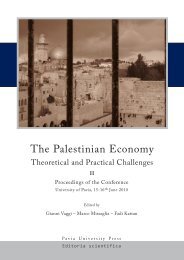Musica che affronta il silenzio - Scritti su Toru Takemitsu - Pavia ...
Musica che affronta il silenzio - Scritti su Toru Takemitsu - Pavia ...
Musica che affronta il silenzio - Scritti su Toru Takemitsu - Pavia ...
Create successful ePaper yourself
Turn your PDF publications into a flip-book with our unique Google optimized e-Paper software.
Music Facing Up to S<strong>il</strong>ence. Writings on Tru Takemit<strong>su</strong><br />
at that date was st<strong>il</strong>l absent in the Japanese potpourri of international music. There is no<br />
doubt that the élan of French music, together with its language, played a major role in<br />
Takemit<strong>su</strong>’s production. What is more, this music sounded ‘modern’ in a way that the academic<br />
output of the German school did not; in the period of Japan’s modernization,<br />
German music had been chosen by the state officials charged with selecting Western<br />
models to be imitated in the various cultural and social spheres. The first chair of<br />
composition in the leading university music department in Japan had been assigned to a<br />
composer grounded in ‘classical’ German studies. On the contrary, French music was<br />
prized by the ‘national’ composers outside the academic establishment who sought to<br />
combine Western musical language with their own sensib<strong>il</strong>ity and musical culture. One of<br />
these composers, Fumio Hayasaka, was the inspiration and mentor for Takemit<strong>su</strong> in the<br />
early years of his career. In 1939 Hayasaka was engaged as a composer of sound tracks by<br />
the major f<strong>il</strong>m studio Th, and Takemit<strong>su</strong> briefly worked for him as assistant.<br />
The post-war years in Japan were harsh and tragic, as we know from Kenji Mizoguchi’s<br />
great f<strong>il</strong>ms. For young people like Takemit<strong>su</strong> it was liberty which was at a premium: liberty<br />
of knowledge, of expression and of research. Many years later he was to say: ‘Music helped<br />
me to be a free person’. 6 Takemit<strong>su</strong>’s musical formation was strictly self-taught and free from<br />
strictures: he listened avidly to every kind of music, studied the books and scores he came<br />
across more or less by chance (in the cultural centre of the occupying forces, in a record shop<br />
in Ginza which imported foreign records, from friends and so on). In 1949, when he was collaborating<br />
with a range of artists on a musical event to mark the opening of an exhibition of<br />
works by Picasso, he founded with others the group Jikkenkb (experimental laboratory)<br />
involving some ten avant-garde musicians, artists, actors, poets and technicians, which had an<br />
enormous influence on <strong>su</strong>bsequent Japanese music and art (Tezuka 2005). The composers<br />
Takemit<strong>su</strong>, Ken’ichir Sat, Jji Yuasa and Kazuo Fukushima studied Japanese counterpoint<br />
and aesthetics, Messiaen and Webern, and questioned their own sensib<strong>il</strong>ity in relation to the<br />
Zeitgeist. In autonomy with respect to parallel experiences in Europe and America they and<br />
other artists elaborated avant-garde languages linked to concrete music, atonality and the<br />
amalgamation of different genres which coalesced in the creation of events uniting sound,<br />
lighting and projected images, featuring some remarkable expedients at a time when technology<br />
was st<strong>il</strong>l quite rudimental. In that period Takemit<strong>su</strong> approa<strong>che</strong>d the contemporary sound<br />
world with the same open-mindedness and, I would say, joy which he was <strong>su</strong>bsequently to<br />
display for the sounds of nature: in the late 1940s he was already talking of composing a piece<br />
using the sound of the city’s undergrounds.<br />
Liberty, above all. We can gain a better understanding of another key question, concerning<br />
cultural aff<strong>il</strong>iation, if we consider what I would call Takemit<strong>su</strong>’s socio-historical<br />
collocation. In 1960 Takemit<strong>su</strong> joined other young artists (including Kenzabur e, Shintar<br />
Ishihara, Shuntar Tanikawa, Hikaru Hayashi) in ANPO (Nichibei anzenpo shjyaku, U.S.-<br />
6 Tru Takemit<strong>su</strong> in a reply to Nishimura, Mainichi Shinbun, 8 January 1990, evening edition.<br />
119

















